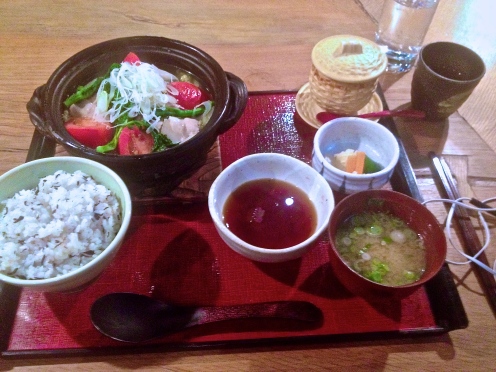When I was in high school, my mother (ahem: Chickpea) came in to my 10th-grade English class to do a demonstration on mindfulness. She’s a psychologist, and we were reading something about meditation, I think, so she was a qualified professional. To my surprise (and my classmates’ delight), she brought in a tray of fresh-baked chocolate chip cookies to aid in her demonstration.
Momma introduced us to the idea of eating mindfully. “Take the cookie in your hand. What is its weight? What does it look like? Consider its smell, and when you taste it, notice how it crunches, and really really taste it.” It was an introduction to how eating—along with any other daily experience, really—can be meditation.
Right now I’m back visiting New York City, which I only recently left after two years, and I’m constantly reminded of how my relationship with this town is the definition of love/hate: There is nowhere busier or faster than the Big Apple. Today I walked past a man who had a cat balanced on his head, I was propositioned for money no less than five times, and many fascinating conversations and smells were imposed upon me. I also had one of the most transcendent moments of meditative stillness in my life—namely, I had a really great lunch.
I decided to treat myself to a meal at Ootoya, one of my favorite restaurants in Manhattan and the world. I’d only eaten there once before, but the concept is so seductive to me: It’s a classy place that serves what they call “authentic Japanese home-cooking.”
I sat at the wooden bar next to a sophisticated-looking woman who, to my surprise, was eating just the dish I was interested in ordering. I had forgotten the name of it, so I waited until she finished a conversation with the waitress, which was conducted entirely in Japanese and involved several petite, dignified bows from the waist. I asked her what she was eating.
“Buta yasai nabe,” she said with lip-smacking satisfaction. “Such classic food for winter.” As far as I can tell, this translates to “pig vegetable pot.”
The waitress brought me a black ceramic cup and filled it with perfectly brewed green tea. I wrapped my fingers around the hot cup and let the steam wash up my nose and into my brain. I noticed that my chopsticks were also ceramic just at the tips, in a way that reminded me of oxford shoes with black-leather toes—textured to grip each bite.
On first impression, this food might be considered plain; it has none of the crispy breading or thick sauces of most Japanese-American food. Just a soup of light, salty, clear soy broth, a few pure-white strips of fatty pork belly. Lots and lots of spongy napa cabbage. Perfectly tender green spears of broccoli rabe, buttery and bitter. And four melting slices of tomato, poached in broth, whose skins fall away in your mouth.
They are such simple ingredients. No real mystery to their preparation. Meat and vegetables in broth. But in lifting each slippery piece of pork, and dipping it into dashi for extra salt—dashi in which I saw shimmering scales—and bringing it to my mouth; and then transferring one soft piece of tomato to my spoon, quivering like jelly; and then a rag of napa cabbage that had soaked up broth like a sponge; one taste came after another like lines in a poem.
The most captivating part of this meal, though, that really elevated it, was the humble-seeming bowl of sticky white rice at the bottom left. The kitchen at Ootoya gives you the option of topping your rice with something as a tasty accent. I chose hijiki seaweed because, I dunno, I usually like seaweed. Nori is fun. Except this seaweed was like something else altogether. I don’t usually expect to be bowled-over by seaweed, but there you are: The hijiki at Ootoya is positively floral. Every bite of that fragrant rice reminded me of lavender and orange peel. It’s like a magic trick, like smelling a fabulous perfume and having no idea who’s wearing it or how a person could smell that good. Seaweed? Most seaweed tastes like seaweed, so why does this one taste like flowers and fruit? Usually with Japanese food you use the rice as a sort of bed for a saucy main dish, but I ate this rice plain, feeling totally surprised by each bite, until it was gone and my belly was full. Hours later I’m still thinking about the impossible taste of lavender and orange peel and salt.
A meal like this, to me, takes on its own particular rhythm. It reminds me that when food is thoughtful, lunch can be just as compelling as listening to an orchestra play. Cooking is just another art form, and when it’s done well, it forces you to slow down and think about it. Like all art, it gives you a glimpse at someone’s thought process, and that’s one of the best parts of being human, I think. And finally, it clears your mind: A good taste, like an interesting chord, demands your full attention. It’s too beautiful to worry about everything else.
With a few bites of tsukemono pickles, and spoonfuls of chawanmushi—a strange, perfectly smooth savory egg custard—I paid my bill and ended my meditation. For the rest of my day, stressed out by the absurdly crowded and overheated subway and all the noise and bustle of the city, I kept returning to the thought of that slow meal, and the seaweed that somehow tasted like flowers.
~Rutabaga


Such beautiful writing!
LikeLike
Headed to The City tomorrow, will do a little meditating.
LikeLike
I was in that class I think!
LikeLike
You definitely were, Clairebear! ❤
LikeLiked by 1 person